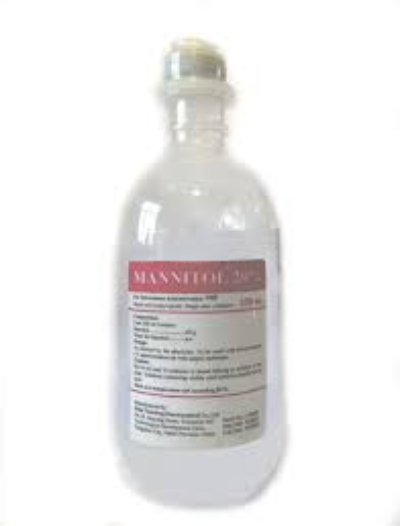


Acute renal failure (oliguric phase): prophylaxis/treatment
Forced diuresis for increased excretion of toxic substances
Osmotic diuresis
Reduction of intracranial pressure
Treatment of cerebral oedema
Urgent and/or pre-operative reduction of elevated intraocular pressure
DOSAGE
The rate of infusion is usually adjusted to maintain a urine flow of at least 30ml/hour to 50ml/hour. Only in emergency situations, the maximum infusion rate can be as high as 200mg/kg infused over 5 minutes. After 5 minutes, the infusion rate should be readjusted to maintain a urine flow of 30ml/hour to 50ml/hour, with a maximum dose of 200g/24 hours.
The following alternative dosing schedule may be suitable:
0.25g/kg to 2g/kg. This dose may be repeated once or twice, after an interval of 4 to 8 hours, if necessary.
The following alternative dosing schedule may be suitable:
Patients should be give a test dose prior to treatment as they are more susceptible to adverse events (See Dosage; Adult).
For intravenous infusion only.
No response to test dose
Pulmonary oedema
Renal failure with anuria
Severe cardiac failure
Severe dehydration
Elderly
Predisposition to hypovolaemia
Breastfeeding
Cardiac impairment
Hyponatraemia
Intracranial haemorrhage
Pregnancy
Severe renal impairment
May obscure/intensify inadequate hydration
Evaluate patients for cardiovascular disease prior to treatment
Avoid rapid infusion rates
Do not mix with whole blood
Examine solution for crystals before use- redissolve if necessary
High doses in large volumes may cause water intoxication/hyponatraemia
If extravasation occurs follow local policy & seek expert help immediately
Perform test dose to determine adequate response
May aggravate pre-existing haemoconcentration
Monitor cardiac function
Monitor central venous pressure
Monitor fluid and electrolyte status
Monitor pulmonary function regularly
Monitor renal function
Monitor serum osmolarity
Monitor urine output
May exacerbate existing or latent congestive cardiac failure
May affect results of some laboratory tests
Discontinue if hypersensitivity reactions occur
Discontinue in the event of progressive cardiac failure
Discontinue in the event of progressive deterioration in pulmonary function
Discontinue in the event of progressive renal damage
Mannitol solution may crystallise during storage. Storing the solution between 20 and 30 degrees C helps prevent this. However carefully examine solution for crystals immediately before use. Crystals can be redissolved by raising the temperature to 60 degrees C and shaking occasionally. Cool to blood temperature before use.
Mannitol may open the blood-brain barrier at high doses, resulting in a rebound increase in intracranial pressure.
Mannitol is not recommended in intracranial bleeding except during craniotomy.
Use mannitol with caution during pregnancy.
There is extremely limited information about its use in pregnancy. Schaefer (2007) states that if an osmotic diuretic is required during pregnancy mannitol may be used, although diuretics are not part of the standard therapy for hypertension and oedema in pregnancy. Schaefer concludes that exposure to a diuretic is not an indication for interrupting the pregnancy.
The use of all medication in pregnancy should be avoided whenever possible; particularly in the first trimester. Non-drug treatments should also be considered. When essential, a medication with the best safety record over time should be chosen, employing the lowest effective dose for the shortest possible time. Polypharmacy should be avoided. Teratogens taken in the pre-embryonic period, often quoted as lasting until 14 to 17 days post-conception, are believed to have an all-or-nothing effect. Where drugs have a short half-life, and when the date of conception is certain, this may allow women to be reassured where drug exposure has occurred within this time frame. Further advice may be available from the UK National Teratology Information Service (NTIS) and through ToxBase, available via password on the internet ( www.toxbase.org ) or if this is unavailable at the backup site ( www.toxbasebackup.org ).
Use mannitol with caution during breastfeeding.
It is unknown if mannitol is excreted into human breast milk. Although there is no hard data, drawing on knowledge of mannitol and mother and infant physiology, one author suggests that passage into the milk is only likely in the first few days post partum, and considers passage into the breast milk likely to be minimal beyond 48 hours post-partum. Further, that oral absorption by the infant is likely to be minimal after the first few days post partum (when the gastrointestinal tract becomes less porous). Watery diarrhoea in the infant is a remote possibility. A reduction in the production of milk, from the osmotic diuretic effect is possible (Hale, 2010).
Neonates, infants born prematurely, those with low birth weight, those with an unstable gastrointestinal function or who have serious illnesses may require special consideration. For any infant, if a drug is prescribed to the nursing mother, it should be at the lowest practical dose and for the shortest time. When drug administration is unavoidable and breastfeeding is to continue, minimisation of exposure of the infant to the drug may sometimes be achieved by timing the maternal doses to just after a feeding episode. Infants exposed to drugs via breast milk should be monitored for unusual signs or symptoms. Interactions between the drug received by the infant from the mother's milk and medication prescribed for the infant should also be considered, for example, when the drug given to the infant may prevent metabolism of the drug received via breast milk.
Acidosis
Acute renal failure
Anaphylactic reaction
Anaphylactic shock
Anuria
Arm pain
Arrhythmias
Asthenia
Azotaemia
Blurred vision
Chest pain
Chills
Circulatory disturbances
Coma
Compartment syndrome
Confusion
Congestive cardiac failure
Convulsions
Cramp
Dehydration
Diarrhoea
Diuresis
Dizziness
Dry mouth
Erythema at injection site
Fever
Fluid and electrolyte disturbances
Haematuria
Headache
Hypersensitivity reactions
Hypertension
Hyponatraemia
Hypotension
Inflammation (injection site)
Itching (injection site)
Lethargy
Local pain (injection site)
Malaise
Nausea
Oedema
Oliguria
Osmotic nephrosis
Palpitations
Polyuria
Pulmonary oedema
Raised intracranial pressure
Rash at injection site
Respiratory depression
Rhinitis
Skin necrosis
Tachycardia
Thirst
Thrombophlebitis
Thrombophlebitis (injection site)
Urinary retention
Urticaria
Vomiting